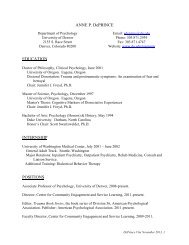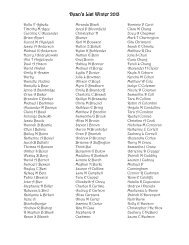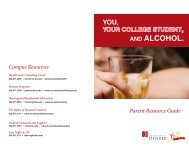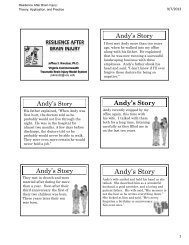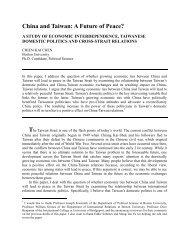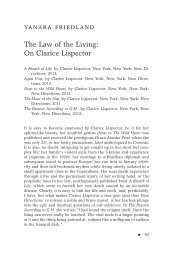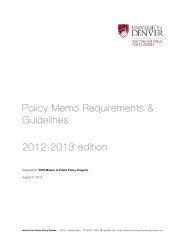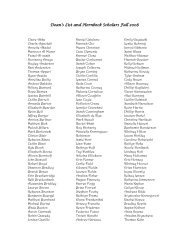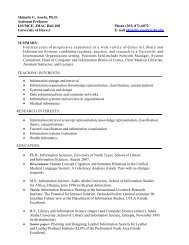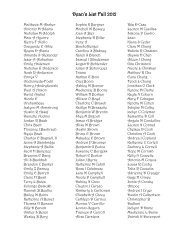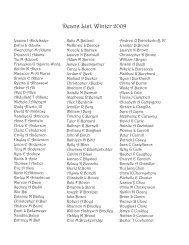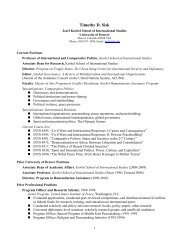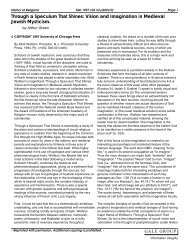Create successful ePaper yourself
Turn your PDF publications into a flip-book with our unique Google optimized e-Paper software.
invitation, back to <strong>GSSW</strong>. New research and training projects have<br />
been launched, more advanced and challenging than any <strong>of</strong> <strong>GSSW</strong>’s<br />
earlier ones. The first <strong>of</strong> these, a research and training project on<br />
conflict and human security in Northern Kenya with Dean Williams<br />
as the Principal Investigator, began in 2010. This one-<strong>of</strong>-a-kind<br />
endeavor includes three partners: <strong>GSSW</strong>, the UNCRD Africa Office and the<br />
<strong>University</strong> <strong>of</strong> Nairobi for field research. United Nations cooperation with<br />
universities and other institutions is frequent enough, but one where a<br />
university dean heads a U.N. research project is truly rare.<br />
Palgrave Macmillan published our research findings last year in the book,<br />
Conflict and Human Security in Africa: Kenya in Perspective. The data revealed<br />
that the current causes and patterns <strong>of</strong> conflict in Northern Kenya are complex<br />
and intertwined with ethnicity, environmental degradation, competition for<br />
scarce resources and the influx <strong>of</strong> illicit arms from neighboring countries.<br />
Cultural practices such as cattle rustling, along with poor governance and<br />
political incitement, add to Kenya’s problems. Severe poverty is a major cause<br />
<strong>of</strong> insecurity in the region. In fact, scholars believe that reducing poverty<br />
by doubling income would reduce conflict by half. This is because people<br />
who have lost their livestock to either cattle rustling or drought have few<br />
alternatives. Lack <strong>of</strong> a stable economy and employment opportunities, as well<br />
as easy access to guns, have led the country’s youth to engage in criminal<br />
activity such as cattle rustling. That is why creating alternative and sustainable<br />
livelihoods is so important.<br />
Now that the Kenya project is coming to a close, what comes next?<br />
Part <strong>of</strong> the answer lies in continuing the work <strong>of</strong> livelihood capacity-building,<br />
started in Northern Kenya, but applicable to the entire country and beyond.<br />
Opportunities are opening for other U.N.-<strong>GSSW</strong> projects in Africa. For example,<br />
a research project has begun in Botswana, again with Dean Williams as the Principal<br />
Investigator. Dr. Asfaw Kumssa (Coordinator <strong>of</strong> the UNCRD Africa Office) and I are<br />
co-P.I.s. As with the previous project, the team includes a national university—the<br />
<strong>University</strong> <strong>of</strong> Botswana, which Dean Williams visited this March.<br />
<strong>GSSW</strong> is now deeply involved in the international arena, serving countries in the<br />
developing world and committed to international social development. So here’s to our<br />
shared global future!<br />
12 spring 12 where in the world is <strong>GSSW</strong>?<br />
At the <strong>University</strong><br />
<strong>of</strong> Botswana in<br />
Gaborone, Dean<br />
James Herbert<br />
Williams (center)<br />
meets with (L-R)<br />
Pr<strong>of</strong>essor Rodreck<br />
Mupedziswa,<br />
Director <strong>of</strong> the<br />
Department <strong>of</strong><br />
Social Work, and Dr.<br />
Asfaw Kumssa from<br />
the United Nations<br />
Centre for Regional<br />
Development.<br />
Brick-making in Kenya<br />
Clinical Pr<strong>of</strong>essor Philip Tedeschi stands at the<br />
entrance to Kenya’s Watha Cultural Centre.<br />
Kenyan crafters use the<br />
wire to make and sell<br />
“snare art,” creating a more<br />
environmentally sustainable<br />
way to generate income.<br />
<strong>GSSW</strong> students in<br />
Kenya remove wire<br />
snares that trap<br />
endangered<br />
animals for the<br />
bushmeat trade.<br />
Promoting Sustainability Through<br />
Capacity-Building<br />
by Clinical Pr<strong>of</strong>essor Philip Tedeschi, MSSW, LCSW-CO<br />
Clinical Director, Institute for Human-Animal Connection<br />
The World Commission on Environment and Development<br />
(WCED) defines sustainable development as that which “meets<br />
the needs <strong>of</strong> the present without compromising the ability <strong>of</strong><br />
future generations to meet their own needs.”<br />
For the past four years, <strong>GSSW</strong> has been translating this concept<br />
into action through MSW courses emphasizing global practice.<br />
Conservation-focused courses and internships are now <strong>of</strong>fered<br />
annually, in Kenya and elsewhere, allowing students to study<br />
the intricate relationship between healthy environments for<br />
people and for animals. This concept, which the<br />
United Nations calls “One Health,” emphasizes<br />
biodiversity and eco-system services as emerging<br />
measures <strong>of</strong> community health and resilience.<br />
The social work concept <strong>of</strong> “person-inenvironment”<br />
does not lose any <strong>of</strong> its potency<br />
when it is applied to the critical conservation<br />
issues people face. On the contrary, at this critical<br />
juncture in our collective efforts to advocate for<br />
biodiversity protection, we must recognize that<br />
empowerment <strong>of</strong> local communities occurs from<br />
the bottom up. This means that our empowerment<br />
efforts must emphasize the practical<br />
realities <strong>of</strong> communities where people work, grow<br />
food, eat and drink, and go to school.<br />
A community’s capacity to advocate for itself<br />
and for environmental health is an important<br />
measure <strong>of</strong> social justice, and the empowerment <strong>of</strong> local people<br />
is at the heart <strong>of</strong> <strong>GSSW</strong>’s immersion service learning courses and<br />
internships. These experiences help students develop the social<br />
work skills and cultural competencies they need to assess and<br />
facilitate solutions to problems within communities that are very<br />
different from their own.<br />
In the MSW course “Social Work in Kenya: Context, Empowerment<br />
and Sustainability,” we collaborate with the African Network<br />
for Animal Welfare to apply concepts <strong>of</strong> ecological economics,<br />
sustainable wildlife management models and cost-benefit valuation<br />
to understanding the roles <strong>of</strong> local people, tribal structure,<br />
government and private/public partnerships intended to create<br />
Where in theWorld is <strong>GSSW</strong>?<br />
Botswana | Kenya<br />
improved sustainable models. Unless sustainable alternatives<br />
are provided to these areas, human-animal conflict arises as<br />
impoverished people poach animals for income or to meet basic<br />
needs.<br />
In addition to removing snares used to trap endangered animals,<br />
<strong>GSSW</strong> students work with communities to promote conservation<br />
and animal welfare. For example, they helped introduce<br />
community-building solutions like high-compression brick-making<br />
machines that <strong>of</strong>fer people a sustainable livelihood. Students also<br />
have become friends, advisors and customers <strong>of</strong> a cultural center<br />
established within Kenya’s Watha community to generate income<br />
from ecotourism. Here, local members demonstrate and preserve a<br />
wide range <strong>of</strong> cultural practices, native dances and basket-weaving<br />
skills that provide environmentally friendly sources <strong>of</strong> income.<br />
Social work and the supporting academic infrastructure can<br />
support these communities’ efforts by establishing best practices<br />
and evidence-based approaches that influence the way scientists,<br />
researchers, policy-makers and businesses think about, and interact<br />
with, our environment. The most powerful point <strong>of</strong> intervention<br />
in the environmental movement is occurring with people on a<br />
local level, a level well-suited for social worker participation.<br />
The Watha:<br />
A Displaced<br />
Culture in Kenya<br />
by Cori Noordyk, concentration<br />
year MSW student<br />
While driving through Tsavo East<br />
National Park, one <strong>of</strong> the oldest<br />
and largest parks in Kenya,<br />
Kazungu suddenly stopped the<br />
Land Cruiser and looked out the<br />
window. He swept his arm across<br />
the horizon in a grand and proud<br />
gesture. “This is where the Watha<br />
used to live,” he said.<br />
MSW student<br />
Cori Noordyk<br />
in Kenya<br />
I stood up through the opening<br />
in the ro<strong>of</strong> and saw the burgeoning river winding through an<br />
expanse <strong>of</strong> plush green meadow. “Kazungu, it is beautiful,” I said.<br />
“Yes, yes,” was his solemn response.<br />
The Watha now live on a small square <strong>of</strong> land on the outskirts <strong>of</strong><br />
Tsavo East National Park. They were once a tribe who lived <strong>of</strong>f the<br />
where in the world is <strong>GSSW</strong>? spring 12 13



